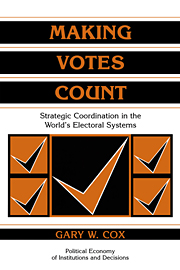Book contents
- Frontmatter
- Contents
- List of tables and figures
- Series Editors' Preface
- Preface
- PART I INTRODUCTION
- PART II STRATEGIC VOTING
- PART III STRATEGIC ENTRY
- 8 Strategic voting, party labels, and entry
- 9 Rational entry and the conservation of disproportionality: evidence from Japan
- PART IV ELECTORAL COORDINATION AT THE SYSTEM LEVEL
- PART V COORDINATION FAILURES AND DEMOCRATIC PERFORMANCE
- PART VI CONCLUSION
- APPENDICES
- References
- Subject Index
- Author Index
9 - Rational entry and the conservation of disproportionality: evidence from Japan
Published online by Cambridge University Press: 05 August 2012
- Frontmatter
- Contents
- List of tables and figures
- Series Editors' Preface
- Preface
- PART I INTRODUCTION
- PART II STRATEGIC VOTING
- PART III STRATEGIC ENTRY
- 8 Strategic voting, party labels, and entry
- 9 Rational entry and the conservation of disproportionality: evidence from Japan
- PART IV ELECTORAL COORDINATION AT THE SYSTEM LEVEL
- PART V COORDINATION FAILURES AND DEMOCRATIC PERFORMANCE
- PART VI CONCLUSION
- APPENDICES
- References
- Subject Index
- Author Index
Summary
In this brief chapter I provide some district-level evidence pertinent to Taagepera and Shugart's Law of Conservation of Disproportionality, a proposition articulated at the system level that hinges on rational entry decisions. Both Taagepera and Shugart (1989:123) and Lijphart (1994:97), among others, have noted that the bivariate correlation between a system's proportionality and its number of parties reflects a reciprocal causal mechanism at work. Increasing the number of contestants (beyond some threshold determined by the electoral system's capacity to dispense seats proportionally, and holding all else constant) decreases measured proportionality. Anticipated deviations from proportionality, however, tend to depress the number of parties. For, if everyone anticipates a disproportional outcome, and everyone agrees that party A will be on the short end of this disproportional outcome, then party A has reason to drop out of the race. But if A does drop out, then the correspondence between votes and seats actually obtained will be less distorted than had been anticipated.
The lesson that Lijphart (p. 97) draws from the reciprocal causation between the number of parties and the proportionality of the electoral outcome is that proportionality measured on the basis of actual vote shares will overestimate proportionality measured on the basis of true preferences: “Assuming that many voters cast their votes for larger parties because they do not want to waste their votes on small parties with poor chances of being elected, the parties' seat shares deviate much more from the pattern of the voters' true preferences than from the actual vote shares.”
- Type
- Chapter
- Information
- Making Votes CountStrategic Coordination in the World's Electoral Systems, pp. 173 - 178Publisher: Cambridge University PressPrint publication year: 1997



